Eye Care

Vision problems today can be identified and corrected without causing any discomfort or worry. Typical signs of vision difficulty include nervousness, irritability or unusual fatigue after concentrated work e.g. use of visual display units by means of computers; preferential use of one eye by turning the head or covering one eye; placing the head close to printed matter to avoid blurring of image; frowning when reading or writing; poor eye - hand coordination; blinking or rubbing the eyes; headaches or dizziness; double vision.
Eye problems also include eye irritations like constant burning and itching sensation leading to eye rubbing, and causing frequent mild eye infections. Environmental pollution also plays a very large role in eye irritations. Systemic diseases like Diabetes, Blood Pressure, Brain tumors can cause visual problems. These can easily be diagnosed in routine eye examinations at a very early stage. Early detection can lead to early intervention and the elimination of the problem before it can have a negative impact on the person’s life.
Common visual defects in children are,
- Refractive errors (spectacle prescription)
- Crossed eye or squint
- Lazy eyes or amblyopia
In order to detect these simple but important causes of childhood blindness one needs their child to have a routine eye examination done between 4-5 years of age by a pediatric ophthalmologist (pediatric eye doctor).
What are Refractive Errors?
The following are the most common refractive errors, all of which affect vision and many require corrective lenses for correction or improvement.
Myopia
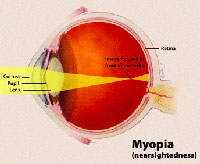 Commonly known as nearsightedness, myopia is a condition in which, an image of a distant object becomes focused in front the retina, either because the eyeball axis is too long, or because the refractive power of the eye is too strong. Myopia is the most common refractive error seen in children. This condition makes distant objects appear out of focus and may causes headaches and/or eye strain. You may notice that your child is holding books too close to his/her face and writing with his/her head very close to the table. This can be corrected using concave lens. Eyeglasses or contact lenses may help to correct or improve myopia.
Commonly known as nearsightedness, myopia is a condition in which, an image of a distant object becomes focused in front the retina, either because the eyeball axis is too long, or because the refractive power of the eye is too strong. Myopia is the most common refractive error seen in children. This condition makes distant objects appear out of focus and may causes headaches and/or eye strain. You may notice that your child is holding books too close to his/her face and writing with his/her head very close to the table. This can be corrected using concave lens. Eyeglasses or contact lenses may help to correct or improve myopia.
Hyperopia
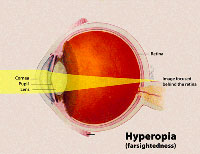 Commonly known as farsightedness, hyperopia is the refractive error in which an image of a distant object becomes focused behind the retina, either because the eyeball axis is too short, or because the refractive power of the eye is too weak. This condition makes close objects appear out of focus and may cause headache, eye strain, and/or fatigue. Squinting, eye rubbing, lack of interest in school, and difficulty in reading are often seen in children with hyperopia. This can be corrected using a convex lens. Eyeglasses or contact lenses may help to correct or improve hyperopia.
Commonly known as farsightedness, hyperopia is the refractive error in which an image of a distant object becomes focused behind the retina, either because the eyeball axis is too short, or because the refractive power of the eye is too weak. This condition makes close objects appear out of focus and may cause headache, eye strain, and/or fatigue. Squinting, eye rubbing, lack of interest in school, and difficulty in reading are often seen in children with hyperopia. This can be corrected using a convex lens. Eyeglasses or contact lenses may help to correct or improve hyperopia.
Astigmatism
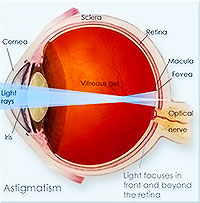 Astigmatism is a condition in which the front surface of the eye, the cornea, has an abnormal curvature - making objects up close and at a distance appear blurry, about 3% of school age children have significant amounts of astigmatism. Some symptoms include headache, eye strain, and/or fatigue. Eye rubbing, lack of interest in school, and difficulty in reading are often seen in children with astigmatism. Depending upon the severity, eyeglasses or contact lenses may be required.
Astigmatism is a condition in which the front surface of the eye, the cornea, has an abnormal curvature - making objects up close and at a distance appear blurry, about 3% of school age children have significant amounts of astigmatism. Some symptoms include headache, eye strain, and/or fatigue. Eye rubbing, lack of interest in school, and difficulty in reading are often seen in children with astigmatism. Depending upon the severity, eyeglasses or contact lenses may be required.
What is a Squint or Crossed Eye?
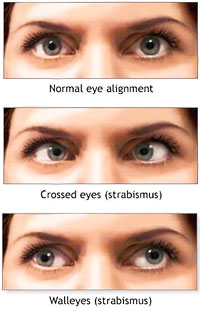 Strabismus, although often referred to as crossed eye is actually the term used to describe any condition in which the eyes are not parallel whether one eye turns or wanders in, or out or up or down. It may be present all the time or it may only appear when a child is tired or ill or concentrating on nearby objects. It may be present at birth or it may not show up until later in childhood or in adult life.
Strabismus, although often referred to as crossed eye is actually the term used to describe any condition in which the eyes are not parallel whether one eye turns or wanders in, or out or up or down. It may be present all the time or it may only appear when a child is tired or ill or concentrating on nearby objects. It may be present at birth or it may not show up until later in childhood or in adult life.
It is common for a new born baby's eye to wonder. At birth, the eye muscles are not coordinated, but within a few weeks the infant learns to move both eyes together and wondering disappear. But if the condition persists beyond 3 months of age, prompt medical attention is required.
Even the most observant parent can sometimes miss detecting a squint; hence it is important to take the child to a pediatric eye doctor for a routine eye examination.
Fortunately it is never too early to have a child's eye examined.
What is the Treatment of a Squinting Eye?
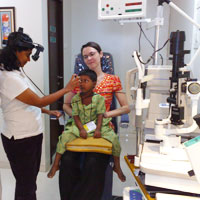 If your child has a squint, the doctor has a specific plan of treatment.
There are three main goals of treatment Vision in the squinting eye maybe improved by glasses and/or patching the good eye so as to make the squinting eye work.
If your child has a squint, the doctor has a specific plan of treatment.
There are three main goals of treatment Vision in the squinting eye maybe improved by glasses and/or patching the good eye so as to make the squinting eye work.
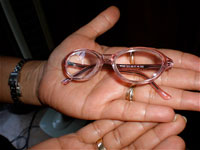 Some squint get corrected by glasses and patching treatment, requiring no further intervention. However some require surgery for alignment of the eyes. The principle of the surgical treatment is to strengthen the weak muscle and weaken the stronger muscle.
Some squint get corrected by glasses and patching treatment, requiring no further intervention. However some require surgery for alignment of the eyes. The principle of the surgical treatment is to strengthen the weak muscle and weaken the stronger muscle.
Reaching these goals may require years of treatment, but remember your child's vision is at stake. The doctor has tools with which to help your child-patching, glasses, surgery and perhaps exercises. But none will be successful without the most important tool of all: your help!
By starting treatment as soon as possible and making sure your child follows the treatment plan, you can help your child take the first step down the road to achieving and maintaining good binocular vision.
What Happens When the Squint is Not Treated?
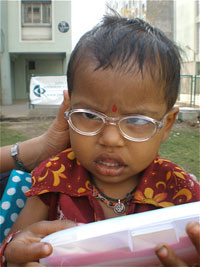 Because it's impossible to focus accurately on two things at once, the brain will ignore input from the squinting eye and use the straight eye to focus. This avoids double version but can lead to Suppression, a condition in which the brain doesn't learn to see normally through the affected (squinting) eye.
Because it's impossible to focus accurately on two things at once, the brain will ignore input from the squinting eye and use the straight eye to focus. This avoids double version but can lead to Suppression, a condition in which the brain doesn't learn to see normally through the affected (squinting) eye.
The vision in the weaker eye over a period of time may decrease leading to amblyopia (lazy eye). If the lazy eye is not treated before late childhood or adolescence it could lead to permanent loss of vision. Besides, a child with a squint has only uniocular vision and not binocular vision.
Squint can cause loss of vision in the affected eye and therefore if you wait till your child enters school, it may be too late to fully correct the squint and improve the vision.
What is Ambylopia or Lazy Eye?
Amblyopia is loss of normal vision in an eye that looks healthy. Amblyopia usually only affects one eye, and is often due to poor focusing secondary to a refractive error in one eye or a turned eye (a squint). Rarely may it be due to cloudiness of the normally clear eye tissues (e.g. a congenital cataract). The best time to correct Amblyopia is during infancy and early childhood or poor vision will be permanent. Parent must be aware of this potential problem if they wish to protect their child's vision.
About 3 to 4% of the children suffer from amblyopia. It is four times more common in premature children.
How is It Detected?
It is not easy to recognize amblyopia. Young children with poor vision in one eye are unaware of the problem. Unless a child has a misaligned or a turned eye, or other obvious abnormality, there is often no way for the parent to tell that something is wrong. Amblyopia is detected through community vision screening or a routine eye examination done at 4-5 years of age.
How Does Normal Vision Develop?
Newborn infants have an immature visual system, during early childhood the visual system continues to develop. By the age of 7-8 years, the visual system is fully developed and the nerve pathways cannot be changed. The development of good vision in both eyes and straight eyes is necessary for normal binocular vision.
If the vision in one eye is lost later in life due to accident or eye disease, it is essential that the other eye has good vision.
How is Amblyopia Diagnosed?
The ophthalmologist will use a variety of tests to measure vision. Drops will be used to dilate the child's pupils and temporarily stop their focusing so that the need for glasses can be accessed. The inside of the eye will also be carefully examined to look for other causes of poor vision.
